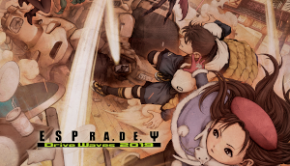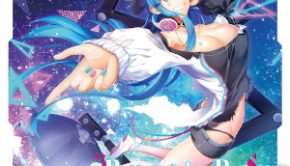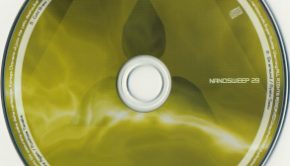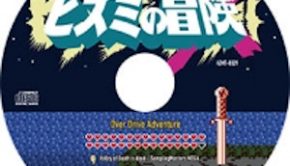Shinji Hosoe Profile
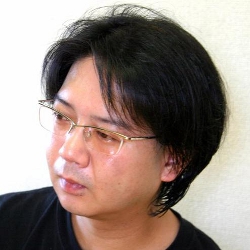 |
Also Known As: 細江慎治 (ほそえしんじ) / mega / MEGATEN / sampling masters MEGA / Samplingmaster MEGA / SamplingMasters MEGA / SamplingMastersMEGA / Tama |
| Date of Birth: February 28, 1967 (Gero) |
|
| Residence: Tokyo |
|
| Game Works: Dragon Spirit, Ridge Racer, Technictix, 999 |
|
| Official Site: Japanese Site |
History
| Organisation | Type | Tenure | Role |
| Namco | Game Developer | 1985 – 1987 | Part-Time Games Tester |
| Namco | Game Developer | 1987 – 1996 | Composer, Sound Designer |
| Troubadour Records | Record Label | 1992 – 2000 | Co-Founder, Producer, Artist |
| Manikyua-Dan | Music Group | 1993 – 1999 | Co-Founder, Artist |
| Sampling Masters | Music Group | 1993 – | Co-Founder, Artist |
| Oriental Magnetic Yellow | Music Group | 1994 – 2001 | Co-Founder, Artist, Keyboards, Guitars |
| Arika | Game Developer | 1996 – 2000 | Composer, Sound Designer |
| SuperSweep | Music Production | 2000 – | Founder, President, Composer |
| Sweep Record | Record Label | 2001 – | Founder, President, Artist |
| DystopiaGround | Music Production | 2009 – | Composer, Arranger |
| GE-ON-DAN | Artist Collective | 2009 – 2011 | Member |
Biography
SuperSweep president Shinji Hosoe is an influential electronic game composer and prolific record producer. Born on February 28, 1967 in Gero, Hosoe was fascinated with music and technology from a young age. Fascinated by some electronic music he heard on his father’s radio, he bought his first record — Isao Tomita’s The Planets — during elementary school and enjoyed listening to it with his sister. Developing this interest into junior high school, he started to play the synthesizer and started a cover band with his friends. Despite this, the artist never intended to pursue electronic music and instead studied CG design at college. After graduating, he was recruited as a game tester at Namco and first helped to debug the NES port of Star Luster in 1985. He was subsequently taken on as a part-time CG artist for titles such as Tower of Babel but, now desiring to work more as a musician, composed secretly for projects in his spare time. After impressing his company, he was taken on a full-time sound creator in 1987.
Hosoe’s debut score, the arcade shooter Dragon Spirit, continues to be remembered fondly to this day. Already aware of the technological restrictions of the era, he accommodated the limitations YM 2151 chip with efficient composition and meticulous programming. He carried listeners into the air with his gliding melodies, while conveying urgency with booming bass lines and ambient sound effects. He enjoyed working with the close-knit development team on the project and felt a great sense of accomplishment when it was completed. Following this success, Hosoe gained a taste of scoring his first driving games with Final Lap; while his score was primitive, his tunes and sound effects still matched the pace of the gameplay. He also created minimal scores for Final Lap 2 and Dirt Fox, both of which were celebrated with album releases under his supervision. Other significant early offerings included a bass-punctuated funk score for Assault, some lively pop-flavoured tunes for Ordyne, and an uplifting synth rock accompaniment to Metal Hawk, all of which matched the developer’s visions for the games.
Hosoe pushed musical and technical boundaries with his numerous arcade scores released during the early 1990s. On Dragon Saber, for instance, the artist greatly elaborated on the foundations of his debut work to motivate listeners to complete the game; the soundtrack featured more musical variety and better quality, and its tracks were catchier for the most part. Victor Entertainment celebrated the music with a double disc album, featuring original and arranged sides. The composer needed to be more ambitious once again on Galaxian 3: Project Dragoon: the game would seat 28 players and feature a 360 degree screen. He created several spacey orchestrations for the title and enhanced the sound quality using a Motorola 68000 chip. In addition, he drafted in newcomers Ayako Saso and Takayuki Aihara into the sound team to complete the work, both of whom would dominate his future collaborations. He also helped to rival Star Wars with Star Blade, adding to the galactic scope of the game with realistic shooting sounds and epic narration.
Hosoe first managed to resonate with the masses through racing games. During the development of 1992’s F/A, he was encouraged to abandon the fusion sound popular in titles such as OutRun in favour of a more cutting-edge sound. He visited various clubs to gain inspiration, and ended up blending rave beats with abstract voice samples throughout the score. The work was unprecedented for its time and inspired numerous subsequent electronic scores. During 1993, he worked on Cyber Sled and Ridge Racer simultaneously. While the former was not commercially successful, it gave Hosoe an opportunity to pursue his underground techno style further and create what he considers his most accomplished work to date. On Ridge Racer, Hosoe hybridised the classic arcade sound with hardcore electronic hits such as “Rotterdam Nation”. As sound producer, he also briefed established partner Ayako Saso and newcomer Nobuyoshi Sano to supplement the soundtrack. The game was a massive hit across the world and inspired a succession of remix albums.
Having become a dominant musician at Namco, Hosoe engaged increasingly in independent activities. He networked with many of the other biggest game artists on a series of releases by Synergy Records and Sawayaka Kikaku. Inspired by these activitie, the artist went on to form an independent label with Takayuki Aihara in 1992, Troubadour Records. Through this label, Hosoe planned and release albums such as Be Filled With Feeling, Great Wall, G.T.R., TOURS, and Game Over, all with a unique concept and tone. Each of these albums featured numerous veteran composers that Hosoe networked with, including Nobuyoshi Sano, Hitoshi Sakimoto, and Yuzo Koshiro, and broke barriers between game companies. He also established the unit Manakyua-Dan to explore writing pop songs for releases such as Kaki-In and Troubadour. While many of these albums made a loss, they were influential in the industry and inspired numerous successors. In a time of limitations, Hosoe gave an opportunity for sound creators to express their own voice and create fully-fledged pieces.
Hosoe developed his electronic style during his final years at Namco. In 1994, he firmly established the Sampling Masters team on Ridge Racer 2, comprising himself, Saso, Aihara, and Sano. After the free-for-all experimentation of the original, Hosoe focused his ideas more on this title and also paid tribute to some favourites with wild remixes. He was also partly responsible for adapting the music of Ridge Racer for Laser Disc and PlayStation. e cloHe closed his time leading the series’ scores on Rave Racer, once again providing high tempo electronic compositions and remixes to match the racing gameplay. The artist was also had a recurring role on his favourite game series, Tekken, responsible for some remixes featured on Namco Game Sound Express Vol. 17 and the PlayStation versions of Tekken and Tekken 2; in each case, he tried to emphasise the twilight setting of the combat with dark electronics. Outside these series, Hosoe took charge of Galaxian 3: Attack of the Zolgear and Cyber Commando, between taking guest roles on Mach Breakers and Cyber Cycles.
After supplementing the minimalist electronic score for Xevious 3D/G, Hosoe decided to quit Namco in 1996. Despite becoming a senior member of the company, he realized his salary would not increase further and looked to start his own company instead. In order to gain enough funds, he joined Arika and soon started work scoring the Street Fighter EX trilogy alongside Saso and Aihara. Deviating from the series’ poppy routes, Hosoe helped to bring the fighting series into 3D with robust electronic pieces and diverse ethnic fusions. He also adapted the first two scores for their PlayStation ports, using higher quality sample libraries, and their highly experimental arranged albums. While he had not scored many fighting titles previously, this did not prove limiting: after all, he placed his focusing on making the games more exciting, regardless of their gameplay. In other works at Arika, he contributed contemporary pieces to the endorsed original album Escape Goat and co-composed stimulating industrial scores for Tetris: The Grand Master and its sequel.
Between such high-profile game works, Hosoe continued to engage in independent activities with three units. He developed the Sampling Masters sound with a series of electronic albums released under Troubadour Records; the initial trilogy of these albums took listeners on journeys through contemporary Asia and outer space, while a fourth featured a continuous 50 minute rave emulating a discotheque. Also enjoying modest success with Manikyua-Dan, he penned several more pop albums with them, including a radio series and Maninology. It was through this band that he also started to cover anime theme songs, notably on Anime de Pon and Majokko de Pon. Also wanting to cover music by one of his long-term favourites, Yellow Magic Orchestra, he established the group Oriental Magnetic Yellow with Aihara, Sano, and Hiroto Sasaki, taking the role of Haruomi Hosono himself. Though he found covering and imitating the band’s music surprisingly difficult, he produced a succession of well-rounded releases with the group. However, he considers the masterpiece of his original albums to be 2197, where 12 artists provided conveyed their fascinating interpretations of how the world would be in 200 years time.
During his time at Arika, Hosoe was given permission to work on several projects for other game companies. On LightWeight and Square’s Bushido Blade, Hosoe contrasted his other fighting scores with a meditative period score featuring traditional Japanese instruments. He channelled electronic influences more on his other works for the publisher, Escape’s Driving Emotion Type-S and Positron’s Internal Section. An intensely colourful shooter, the latter featured a colourful yet urbanised score written specifically to be in synch with the pulsation of the tube gamers travelled in. His services were also outsourced to Noise and Nintendo on Custom Robo; for this project, he particularly enjoyed underscoring the title’s elaborate story while exploring Nintendo’s particular hardware. Having also gained a reputation as a desirable arranger, he also made contributions to the album releases for Fighters’ Impact, The Season of L, StarSweep, DeviceReign, and Yukyu Gensoukyoku 3. The much-demanded composer concluded his time at Arika by co-composing Street Fighter EX3 and Tetris: The Grand Master 2.
After close consideration, Hosoe decided to leave Arika in to form his own company. Founded on February 14, 2000, SuperSweep would have two main arms. As a record label, it would succeed Troubadour Records and publish a range of original, soundtrack, and remix albums. As a music production company, it would be contracted to work on various games in composition, arrangement, sound design, voice recording, and manipulation roles. Hosoe took on previous collaborators such as Ayako Saso, Yousuke Yasui, and Zunba Kobayashi to ensure the company would be a versatile and productive one. As the president the company, he found himself burdened by more administrative and management responsibilities than before. He nevertheless continued to cultivate his talents as an electronic composer, notably creating the Sampling Masters album Never Float, the Manikyua-Dan compilation Dokidoki Memorial, and the final Oriental Magnetic Yellow release Nancy Boys at the start of the millennium. It was the start of a major new era for the artist and businessman.
During the first years of SuperSweep, Shinji Hosoe expanded his clientele. Despite his departure, he was asked by Arika to produce the score for two rhythm games, Technictix and Technicbeat. The titles provided unique challenges, given he needed to carefully accommodate the rhythm of the gameplay and the specifications of the hardware; he nevertheless persevered to produce a diverse and entertaining score, incorporating numerous classic remixes into the Namco-published sequel. At the company’s request, Hosoe also pioneered the scores for Mega Man Battle Network Transmission and a mahjong title. Simultaneously cultivating his relationship with Noise, he served as the sound director of Custom Robo V2 and Custom Robo GX. He also accepted requests to work on smaller titles, many of them developed by his old friends. These ranged from the electronic scores to indie games such as Prodigy Racing and Goro Explosion, to theme songs for bishoujo games by Will and Stone Heads, to browser and mobile adaptations of franchises such as Earth Defense and Starblade. Regardless of the budgets, Hosoe efficiently delivered goods meeting the specifications.
With this proven track record, Hosoe won contracts from several major clients between 2003 and 2005. He led the scores for a line of anime-to-game adaptations, namely Bandai’s Gundam Battle Online and Tomy’s Naruto: Clash of Ninja series. On both titles, he paid special attention to the desires of the clients in order to appease fans of the original animes. Also continuing to pursue bishoujo games, he created prominent scores for Perfect Prince, Angel Maker, Sister Contrast, Hunks Work Shop, and The Witches of Salem. He was disappointed by the outcome of his two biggest projects, however. His electro-orchestral score for Namco’s Xenosaga Episode II was often compared unfavourably to its predecessor and never received an album release. He also developed an epic score for Square Enix’s MMORPG Ambrosia Odyssey, but regrettably the title was never released. More satisfying was his debut on Konami’s Bemani line, with two exotic remixes on Keyboardmania 3rd< Mix and two hardcore techno tracks on beatmania IIDX 5th Style. Such popular successes ensured his return to subsequent titles.
During these years, Hosoe maintained a modest output through his record label. SuperSweep initially focused on publishing soundtrack releases for its employee’s various projects, including those by former members Yasuhisa Watanabe, Norihiro Furukawa, and Masashi Yano. However, the label’s scope expanded with several series of electronic mini-albums, namely Techno Rider Tammy, Trash, and NanoSweep. The NanoSweep series particularly took off — reuniting Hosoe and employees with the current Namco team — and continues to sell well at the semi-annual Comic Market events. In 2004, Hosoe also established his involvement in a long-running monthly series of club events, Linear. Alongside names such as Yuzo Koshiro and Hiroshi Okubo, Hosoe has DJed new tracks and remixes to packed clubs. In addition, his services as an arranger have also been frequently requested by other record labels such as Scitron, Team Entertainment, and 5pb; his numerous arrangements span Nintendo’s classics, Sega’s favourites, Level 5’s RPGs, Taito’s puzzlers, SNK’s fighters, and Touhou’s shooters. In addition, he has arranged numerous bishoujo albums, including the character vocal singles for Ever17, Remember11, Memories Off, and DA:BLACK.
As a game composer, Hosoe produced a number of contemporary scores in subsequent years. At the request of Cave, he created a hard rock score for the arcade shooter Ibara in 2005; while the composer felt inexperienced composing in this style, he persevered to produce an energetic and memorable score. Hosoe also appealed to listeners with his nostalgic funk improvisations for the Dreamcast shooter Under Defeat and a harder metal accompaniment to the Xbox brawler Spikeout: Battle Street. The reliable musician also continued his involvement with Bandai’s video games, including the ensemble scores for SD Gundam: Gashapon Wars, Zatch Bell! Mamado Fury, and Super Dragon Ball Z, focusing on hybridising different styles. After a ten year absence, Hosoe was asked to return to the Ridge Racer series for its PSP instalments; with a mixture of originals and remixes, Hosoe’s contributions brought a nostalgic touch to the ensemble scores. Still valued as an ex-employee, Hosoe contributed some extended techno tracks to Ridge Racer 6 and Ridge Racer 7, and eventually published the former’s soundtrack through SuperSweep.
Following a guest contribution to Monster Kingdom: Jewel Summoner, Hosoe received the opportunity to lead a fully-fledged RPG score in 2007, the PlayStation 3’s Folklore. In contrast to the majority of his works, he focused on providing dark dissonant orchestrations and eerie ambient soundscapes throughout. He didn’t find the project especially challenging, given his affinity for dark music and the availability of sample libraries, though the final score surprised many of his followers. Two years later, he offered a dark cinematic score dedicated to Chunsoft’s visual novel 999: Nine Hours, Nine Persons, Nine Doors; in this case, however, he focused on immersing listeners with electronic soundscapes rather than symphonic epics. Simultaneously, he led the sound production of 3D Dot Game Heroes, a retro-influenced RPG; given the title blended 2D and 3D graphics, he decided to hybridised orchestral samples with chiptune emulations throughout. Between such roles, he also made guest contributions to rhythm games of the beatmania IIDX, pop’n music, Taiko: Drum Master, and DJMax lines, while supplementing Let’s Tap with some denser tracks.
In recent years, Hosoe has expanded SuperSweep into one of the most prolific publishers of game albums. The company has established contracts to publish physical soundtracks on behalf of game companies, such as NBGI, Idea Factory, Taito, G.rev, and Milestone, when other labels were disinterested. He also serves as a distributor for albums published by Hitoshi Sakimoto’s Basiscape, Hideki Sakamoto’s noisycroak, Hiroto Saitoh’s LILT, Shoichiro Sakamoto’s Sound Sepher, and Linear’s organisers. Through the Game Music Discovery series, Hosoe also publishes numerous soundtracks dedicated to retro games, including Manabu Namiki’s early works, Atlus’ classic scores, Mega Man Network Transmission, and his own origin scores. Already famed as a remixer, Hosoe has also started to produce arranged albums of his own. Most notably, he expanded on Technictix’s tracks with a trilogy of experimental albums, between offering tributes to Hanii in the Sky, Arcana Heart 2, Mamoru Has Been Cursed, Zed Blade, Thunder Dragon 2, and Monster Hunter. Independently, he has also responsible for a catchy techno arranged album dedicated to Mega Man, a voice mix album for Persona 3 Portable, some chiptune anime remixes on Famison 8-bit, and several remixes of Cave’s favourites.
Hosoe has scored several major projects recently. He made his surprising debut as an animation composer on the short series Meat or Die and YANS!GANS. He also offered an uplifting electronic score for the visual novel Fate/Extra and a collection of moody escape and story themes for the sequel Zero Escape: Virtue’s Last Reward. Despite his high-profile accomplishments, no project remains too small for Shinji Hosoe. He still dedicates the time to score indie titles such as Impetuth and Prismatic Solid with close-knit circles, pen theme songs for bishoujo albums with groups such as DystopiaGround and Super Shot, and participate in large-scale collaborations for Ridge Racer’s portable instalments, Taito’s rhythm games, the Otomedius series, and Tekken 6. Also remaining active as an independent artist, he continues to contribute electronic pieces to projects such as NanoSweep, Megalomachia, and, through the Sampling Masters line, Overdrive Hell on a yearly basis. Featured on over 100 scores and 300 albums, Hosoe is undoubtedly one of the most prolific and successful musicians in the games industry. With SuperSweep’s scores and albums amassing, it looks like there is no chance of him slowing down any time soon.
References:
– Various Game & Album Credits
– VGMdb Discography
– Official Site (English)
– Company Site (Japanese)
– Interview with RocketBaby (English, June 2003)
– Interview with GA-Core (Japanese, January 2009)
– Interview with Game Music Online (English, January 2010)
© Biography by Chris Greening (July 2011). Last updated on April 30, 2013. Do not republish without formal permission.
Posted on April 30, 2013 by Chris Greening. Last modified on March 21, 2014.

